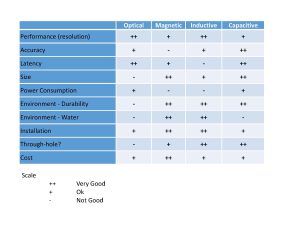Browse:
- Home
- Student Projects
Student Projects
We do stuff with students hooray!

Past Projects

Info Form

Inventory
FAQs
I thought rotary encoders used optical discs, but now I’m finding other options such as magnetic, capacitive and inductive. How do I determine which is right for my application?
Each sensor technology has its own strengths and weaknesses and within each technology there is a broad range of options. For example, some optical encoders cost $20 and others cost $10,000. The chart below is a very generalized overview of how the different technologies stack against one another and it should be noted that exceptions do exist.

For further reading see our blog post ‘Encoder Technology Overview’.
For more information on the right sensor for your specific application please feel free to reach out to Everight Position:
856-727-9500
info@evrtp.com
and one of our specialists will work to find the best solution.
Incremental Encoders
Incremental devices provide position change information only, so the actual position (0-360°) is unknown at startup. A once-per-rev index/marker signal defines the zero position or null of the device. It can be detected during a homing routine if needed.
Incremental sensors are typically small, accurate and cost-effective. They provide essentially instantaneous position information with minimal latency.
Absolute Encoders
Absolute devices provide the actual physical position within one revolution. Homing elimination is a major advantage as this process takes time and isn’t always possible depending on the physical limits of the application.
Absolute sensors are usually bigger and more expensive than incremental devices. Data processing of multiple tracks and serial transmission can increase the latency of position reading. Absolute sensors are available in a wide variety of interfaces including analog (voltage, current), SSI, BiSS, CANopen, J1939 and many Ethernet based protocols.
Absolute Multi-Turn
Rotary, multi-turn devices provide actual position over multiple revolutions. Homing can be eliminated. Multi-turn devices incorporate internal gearing, a battery backup or a self-generated pulse counter such as a Weigand Wire.
While Positek sensors are manufactured to never need to be calibrated, we do understand that sometimes it can be necessary to confirm the sensors functionality and linearity.
Full instructions can be viewed here: https://www.positek.com/contentfiles/files/Linear_Calibration_Instructions.pdf
Note, you will need a sensor where the ‘trim pots’ are accessible to make this adjustment.
If it is a Gill liquid level sensor, yes you can. Some lower-end capacitive sensors rely on the tank housing to complete the circuit necessary to measure the liquid level, however Gill liquid level sensors are fully enclosed, and thus can be used in tanks made of any material. Gill sensors can even be mounted at an angle or upside down with no loss of performance.

 856-727-9500
856-727-9500